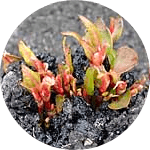Cotoneaster Removal & Control

The overview
Common Name: Cotoneaster Species (Wall Cotoneaster, Himalayan cotoneaster, Entire-leaved Cotoneaster, Hollyberry Cotoneaster, Small-leaved Cotoneaster)
Latin name: Cotoneaster horizontalis Cotoneaster integrifolius Cotoneaster simonsii Cotoneaster bullatus Cotoneaster microphyllus
In Detail
- Species are native to East Asia and were first introduced to the UK in 1824 as ornamental plants.
- There are now over 100 species cultivated in the UK, not all species are listed as Schedule 9 Species.
- Once established the species can dominate areas outcompeting native flora creating dense thickets
- Seeds are spread over large areas by birds as they feed on the berries, seed longevity may be several years
Who we help
We have a long track record of managing some of the most complex sites in the country and have worked with the Environment Agency on several large flood alleviation projects, as well as providing advice to the majority of house builders and developers in the UK.
Click here to view who we help







Identification
- A large group of shrubs and small trees, some deciduous and some evergreen
- Wall Cotoneaster is the most widespread of the species in the UK and has distinctive flattened branches which spread horizontally in a ‘herringbone’ shape.
- Himalayan cotoneaster is an erect deciduous shrub which grows to 3-4 metres in height, the leaves of this species are 1.5-2.5 cm long
- Small-leaved cotoneaster is an evergreen species with very small leaves 0.5-0.8cm long
- All Cotoneaster species are thorn-less, leaves are shiny and hairless on the upper surface and slightly hairy on the underneath of the leaf
- The plants produce small white of pink flowers in spring and summer followed by red/orange berries in clusters
What’s the problem?
- Cotoneasters are non-native species which can quickly out compete native plants.
- Berries are fed upon by birds dispersing seeds over large areas.
- Forms an extensive root system which is difficult to remove.
- Legal implications if allowed to spread onto neighbouring land.
What are the Legal Implications? *England
- Listed as a Schedule 9 species under the Wildlife and Countryside Act 1981.
- It is an offence to plant or allow to spread onto adjacent land and into the wild.
- Possible fines and prison sentence under the Wildlife and Countryside Act 1981.
- It is not an offence to have Cotoneaster species on your land and you do not need to notify anyone on the presence of this species.
- Soils containing Cotoneaster species are classified as controlled waste and should be disposed of at licensed landfill.
Control Methods
Mechanical Control
- Young seedlings can be effectively pulled however larger plants will develop multiple stems from the large root mass making it difficult to remove the whole plant
- Root mass can be excavated to remove entire plant and prevent regrowth
- Material should be chipped or burnt on site or removed to licensed landfill as controlled waste
Chemical Control
- It is possible to spray smaller plants with herbicide however chemical uptake in larger plants is reduced
- Addition of wetting agents improve uptake of herbicide
- Larger plants should be stump treated after cutting to prevent regrowth
If you have concerns over Cotoneaster on your land, if you are unsure of your legal responsibilities, or, if you would like a quotation for control, please contact one of our specialist surveyors. Treatment costs start at £380.00 + VAT.

Where we have worked
We operate nationwide with a Rapid Response Team on standby 7 days a week, to deal with the most urgent client enquiries.
We’re a dedicated team of professionals who share a great deal of experience. We invest heavily in the continual training of all our employees, ensuring you always have a highly qualified team working on your project with the latest industry accreditations.
Our process

1. Identify
Our first step is to identify if you have an invasive plant. For a quick ID, you can send us some photos. Alternatively, we can carry out a full site survey to confirm the extent of the infestation.

2. Solution
We will provide a range of treatment options individually tailored depending on your site requirements.

3. Quote
A detailed breakdown of costs for each phase of treatment will be provided, including on-going monitoring programmes with insurance backed guarantees.

4. Removal
Our experienced and professional in-house teams will carry out the treatment to the highest of standards to achieve full eradication. All works are carried out in accordance with the INNSA Code of Practice.

5. Treatment
A range of treatment solutions are available, from in-situ herbicide application to excavation and removal or burial. All carried out in-house by our experienced team.

